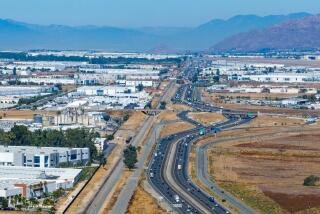71-Acre Industrial Park Taking Root at Koll Development’s Plantation
- Share via
Koll Development Co. of Newport Beach has broken ground on Plantation, a 71-acre industrial park in Industry that will include more than 1.4 million square feet of manufacturing and warehouse space.
Koll estimated construction costs at $30 million for the first phase and $50 million for the second phase, both of which are scheduled to be finished by next summer. The project, at Grand Avenue and Valley Boulevard, was slated to be completed by the end of 2001, but the development schedule was accelerated because of “increasing demand for quality industrial space,” the company said.
The first phase of the development will have six buildings, ranging from 30,000 to 300,000 square feet, and totaling 583,031 square feet. It is expected to be finished in March. The second phase will include three buildings totaling 807,517 square feet. Among the companies planning to move into the industrial park are CTX International, a computer products supplier, and Gemini Foods Inc. CTX has signed a 10-year, build-to-suit lease-purchase agreement valued at $17 million for 321,600 square feet of space, and Gemini has signed a $6-million deal to buy a 73,000-square-foot build-to-suit industrial building.
The project is called Plantation because the site was once a farm where animals’ food supplements were produced. The development will include landscaping and plantation equipment designed to reflect that history, Koll said.
Koll’s project is on one of the few parcels of land available for large new industrial developments in the San Gabriel Valley, a mature market where most new industrial construction is so-called in-fill.
The new project is also one of the few large industrial developments underway in Los Angeles County, where experts say demand for modern space is strong despite the existence of nearly 850 million square feet of industrial buildings.
Much of the existing industrial space in Los Angeles County is already filled, however, but even when it’s available, it often lacks features that modern industrial users demand. Today’s warehouses tend to be larger and to have higher ceilings because modern inventory storage systems stack merchandise considerably higher. Industrial developments today also provide larger truck-turning radiuses, more efficient fire sprinkler systems and a number of other features usually not available in older buildings.
The lack of available land in Los Angeles County has produced an industrial building boom in recent years in Riverside and San Bernardino counties, where industrial space now exceeds 163 million square feet, surpassing the San Gabriel Valley’s approximately 155 million.
The relative lack of new industrial construction in Los Angeles County and the migration of industrial users to the Inland Empire has caused concern among L.A. County economic officials, who say Los Angeles loses businesses and jobs when companies locate elsewhere.
“When an out-of-town company asks us where it can find 100,000 square feet of quality warehouse space, we wince,” said economist Jack Kyser of the Los Angeles County Economic Development Corp. in an interview earlier this year.
More to Read
Inside the business of entertainment
The Wide Shot brings you news, analysis and insights on everything from streaming wars to production — and what it all means for the future.
You may occasionally receive promotional content from the Los Angeles Times.










